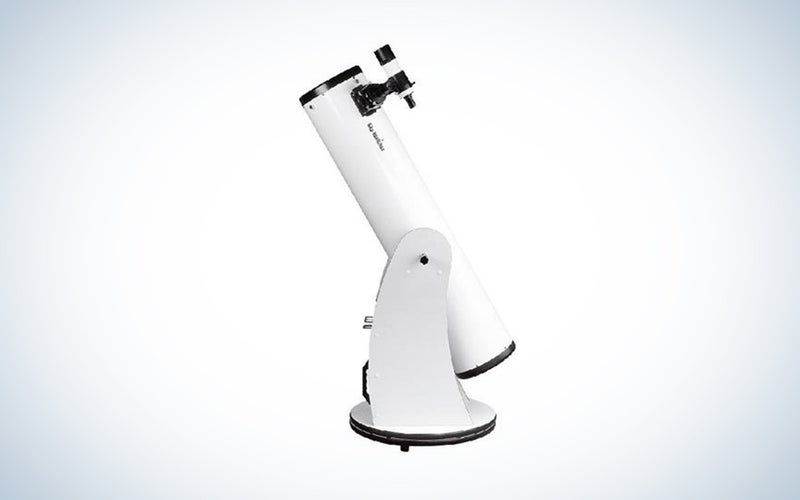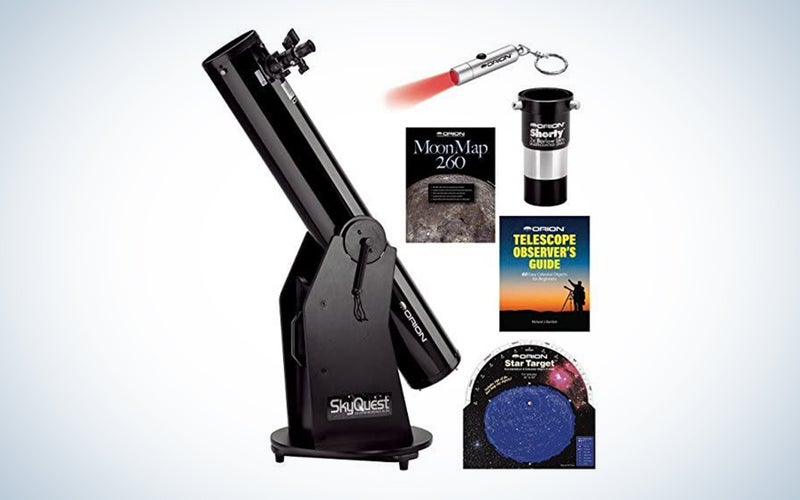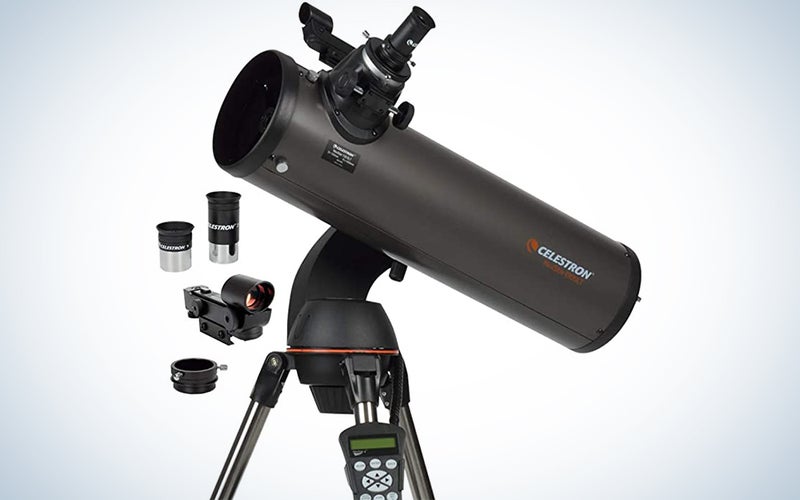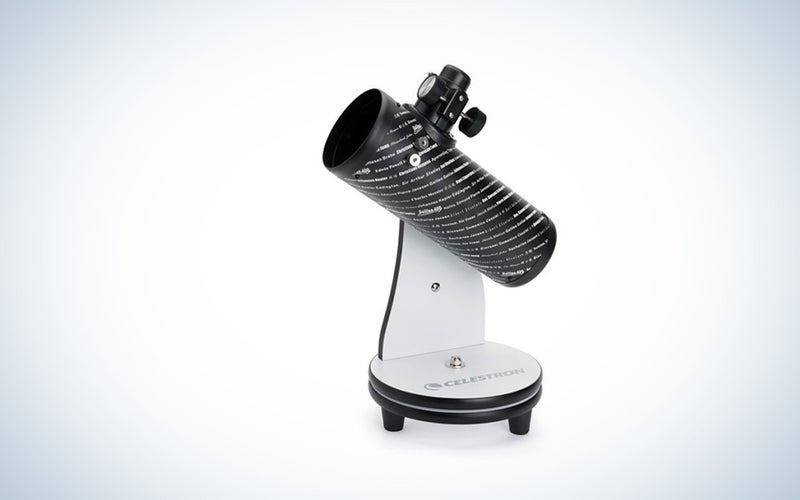
We may earn revenue from the products available on this page and participate in affiliate programs. Learn more ›
It might feel like there’s always a new space event every few weeks—and a telescope can help you make the most of the experience. Viewing the planets doesn’t require too much work, but the optical power of a good telescope can allow you to get a much better picture of the galaxy. Here are our recommendations for the best telescopes to suit a range of needs:
- Best tabletop: Sky-Watcher Classic Dobsonian 8-Inch
- Best for beginners: Orion SkyQuest XT6 Classic Dobsonian Telescope Kit
- Best for travel: Celestron NexStar 130
- Best budget: Celestron FirstScope Telescope and FirstScope Accessory Kit
How we chose the best telescopes
To compile our recommendations for the best telescopes, we first reached out to experts. According to Bart Fried, executive vice president of the Amateur Astronomers Association of New York, you don’t need a pair of binoculars or a telescope to view Mercury, Venus, Mars, Jupiter, and Saturn in the sky.
“The ones that were known to the ancients are visible naked eye,” Fried says. “So if they know where to look, they can watch the planets and see them move in relation to the background stars over time.”
But to see more detailed images of the planets, such as Saturn’s rings or Jupiter’s moons, you’ll want to use a telescope. For amateur astronomers, experts recommend using a Dobsonian telescope.
“They come in many different sizes, are very simple to set up and use, and give you great views of planets, galaxies, and nebulae,” says Jeffrey Miller, an astronomer at St. Lawrence University in Canton, New York.
The best telescopes: Reviews & Recommendations
Best tabletop: Sky-Watcher Classic Dobsonian 8-Inch
This telescope model comes with a two-inch focuser and 1.25-inch adapter that allows viewers to choose between either eyepiece size. The four-arm secondary mirror bracket helps cut down on light loss and diffraction spikes. Plus, this model includes a 9×50 finderscope and a tension control handle.
Best for beginners: Orion SkyQuest XT6 Classic Dobsonian Telescope Kit
This portable telescope pick offers a stable mount, a 1.25-inch 25mm eyepiece, and a red dot sight to help accurately view the planets. The telescope comes with a stargazer guide and moon map for amateurs to easily make new discoveries.
Best for travel: Celestron NexStar 130
For an expansive view of the cosmos, this computerized telescope pick features a Newtonian reflector optical design with a 130mm-aperture that lets you see the clouds around Jupiter and the surface of the moon in great detail. This model also comes with a database that allows you to track 40,000 galaxies, stars, and more; is WiFi-compatible, and comes with interactive sky-simulation software. Yet it’s still compact enough to easily pack on family trips.
Best budget: Celestron FirstScope Telescope and FirstScope Accessory Kit
The Celestron FirstScope Telescope’s 12.5-millimeter eyepiece helps increase magnification to 24 times while the six-millimeter eyepiece offers a magnification of 50 times, allowing you to observe the planets’ features. The 5×24 finderscope helps you locate your favorite celestial bodies. Best of all, it’s easy to transport, so you can explore wherever you are.
Things to consider when selecting the best telescope for you
There are plenty of telescopes to choose from, but there are a few things to consider when picking the right one for you.
Magnification
To see details on the planets, Princeton University professor of astrophysical sciences Gaspar Bakos recommends a device with fairly high magnification. According to Bakos, magnification of 30- to 40-times will help you see things like Jupiter’s moons and Saturn’s rings. To see a phenomenon like Mars’ ice caps, you’ll need a magnification of around 100.
Lens
For Miller, a telescope’s most important feature is the diameter of its primary mirror or lens. He says that the telescope should have as large a mirror or lens as fits your budget and is still easy to move.
The minimum aperture Fried recommends is a three-inch refractor or a four-inch reflector.
“A good overall starter telescope would be a six-inch reflector on what’s called a Dobsonian mount,” Fried says. “Another really good sort of classic starter would be a three- to four-inch refractor and for the refractor, I would probably recommend a manual equatorial mount.”
Portability
You don’t need a massive telescope to see your favorite planets. Both Miller and Fried agree that a smaller telescope that’s easier to transport is going to serve you better.
“If you’re a beginner, you want a telescope that is portable enough that you will take it out — it’s not going to sit in a closet because it’s too heavy or it’s too big, and you can’t get it in a car,” Fried says.
Ease of use
Nowadays, telescopes can have tons of extra features, from electrical hookups to computerized controls. But, these can make the telescopes more expensive and difficult to use. Plus, using a fancy electronic telescope that finds planets for you may take away from the experience.
“On one hand, they’re highly practical, right, because you will actually find things,” Bakos says. “On the other hand, you don’t learn as much as doing it the hard way.”
Final thoughts
- Best tabletop: Sky-Watcher Classic Dobsonian 8-Inch
- Best for beginners: Orion SkyQuest XT6 Classic Dobsonian Telescope Kit
- Best budget: Celestron FirstScope Telescope and FirstScope Accessory Kit
- Best for travel: Celestron NexStar 130
If you’re interested in seeing the planets up close, one of the best telescopes will greatly improve the experience. There are options for beginners and experienced stargazers alike from our recommendations.
Why trust us
Popular Science started writing about technology more than 150 years ago. There was no such thing as “gadget writing” when we published our first issue in 1872, but if there was, our mission to demystify the world of innovation for everyday readers means we would have been all over it. Here in the present, PopSci is fully committed to helping readers navigate the increasingly intimidating array of devices on the market right now.
Our writers and editors have combined decades of experience covering and reviewing consumer electronics. We each have our own obsessive specialties—from high-end audio to video games to cameras and beyond—but when we’re reviewing devices outside of our immediate wheelhouses, we do our best to seek out trustworthy voices and opinions to help guide people to the very best recommendations. We know we don’t know everything, but we’re excited to live through the analysis paralysis that internet shopping can spur so readers don’t have to.




